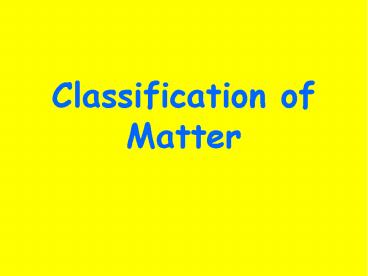Classification of Matter - PowerPoint PPT Presentation
Title:
Classification of Matter
Description:
Classification of Pure Substances Elements Compounds Elements Elements are the ... Classification of Matter Two Classifications ... Document presentation format: On ... – PowerPoint PPT presentation
Number of Views:246
Avg rating:3.0/5.0
Title: Classification of Matter
1
Classification of Matter
2
Two Classifications of Matter
- Pure Substance
- Mixture
3
Pure Substance
- A pure substance has the same composition
throughout and does not vary from sample to
sample.
4
Classification of Pure Substances
- Elements
- Compounds
5
Elements
- Elements are the basic building blocks of matter
- They can not be decomposed by a chemical change
- Each element has a unique set of chemical and
physical properties - All elements are composed of atoms ( the basic
unit of matter) - Elements are represented by symbols- the 1st
letter is always capitalized and the last letter
is lower case (ex. Na)
6
Examples
Sodium
Chlorine
- Properties of Cl
- Gas
- Yellow
- Poisonous
- Properties of Na
- Solid
- Grey metal
- Reacts violently with
- water
7
Lets explore more elements and their properties
8
Compounds
- Compounds are composed of two or more elements.
- Elements in a compound have had their physical
and chemical properties altered as a result of
being chemically bonded via a chemical reaction. - Compounds can be decomposed into two or more
simpler compounds or elements by a chemical
change.
9
Compounds are represented by
- Chemical Formulas which use element symbols and
subscripts to show which elements and how many
are in the compound. - Ex. NaCl, MgCl2
10
Examples
- 2Na Cl2 ? 2NaCl
- Properties of NaCl
- Solid
- White
- Does not react with water.
Sodium Chloride
Notice how the unique properties of
the elements in the compound have been changed.
11
Mixtures
- A mixture contains more than one substance.
- The composition of a mixture can vary from
sample to sample however, each component of a
mixture retains its own unique physical and
chemical properties. - Mixtures can be separated by physical means.
12
Classification of Mixtures
- Homogeneous
- Heterogeneous
13
Homogeneous Mixtures
- Homogeneous mixtures are also known as solutions.
- They have a uniform composition and the
components can not be seen as separate.
Lemonade
Vinegar
14
Heterogeneous Mixtures
- Heterogeneous mixtures do not have a uniform
composition and the components can be seen as
separate.
Granite
Pizza
15
Separation Techniques
- Filtration
- Distillation
- Crystallization
- Chromatography
16
Filtrations
- Used to separate heterogeneous mixtures.
- The mixture is poured through a piece of paper
which allows the liquid part to pass and catches
the solid portion.
17
Distillations
- Used to separate homogeneous mixtures.
- This technique takes advantage of different
boiling points.
18
Crystallization
- Used to separate homogeneous mixtures.
- The liquid portion is allowed to evaporate and
the solid portion remains behind as a crystal.
19
Chromotography
- Separation occurs by allowing a mixture to flow
along a stationary substance (usually
chromotography paper).































